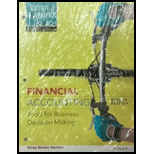
Bundle: Financial Accounting: Tools for Business Decision Making 8e Binder Ready Version + WileyPLUS Registration Code
8th Edition
ISBN: 9781119221647
Author: Paul D. Kimmel
Publisher: Wiley (WileyPLUS Products)
expand_more
expand_more
format_list_bulleted
Question
Chapter 10, Problem 10.18E
a.
To determine
Liquidity ratio measures the short-term capacity of a company to pay its maturing obligations and to meet unanticipated requirements for cash. Liquidity ratios are
To Calculate: The Current ratio for the year 2017.
To determine
To Compute: The current ratio for the year 2016.
(b)
To determine
To Calculate: The Current ratio for the year 2017, if the company used $1.5 million cash to pay off $1.5 million of accounts payable.
(c)
To determine
To Explain: If UB has undrawn operating line of credit of $12.5 million, it would affect UB short term liquidity.
Expert Solution & Answer
Want to see the full answer?
Check out a sample textbook solution
Students have asked these similar questions
Explain the concept of materiality in accounting. Need
What is the difference between a contra asset account and a liability? No ai
What is the difference between a contra asset account and a liability?
Chapter 10 Solutions
Bundle: Financial Accounting: Tools for Business Decision Making 8e Binder Ready Version + WileyPLUS Registration Code
Ch. 10 - Prob. 1QCh. 10 - Prob. 2QCh. 10 - Prob. 3QCh. 10 - Prob. 4QCh. 10 - Prob. 5QCh. 10 - (a) Identify three taxes commonly paid by...Ch. 10 - Prob. 7QCh. 10 - Prob. 8QCh. 10 - Contrast these types of bonds: (a) Secured and...Ch. 10 - Prob. 10Q
Ch. 10 - Prob. 11QCh. 10 - Prob. 12QCh. 10 - Prob. 13QCh. 10 - Lee and Jay are discussing how the market price of...Ch. 10 - Prob. 15QCh. 10 - Prob. 16QCh. 10 - Prob. 17QCh. 10 - Prob. 18QCh. 10 - Prob. 19QCh. 10 - Prob. 20QCh. 10 - Prob. 21QCh. 10 - Prob. 22QCh. 10 - Prob. 23QCh. 10 - Prob. 24QCh. 10 - Prob. 25QCh. 10 - Prob. 26QCh. 10 - Prob. 27QCh. 10 - Prob. 28QCh. 10 - Prob. 29QCh. 10 - Prob. 30QCh. 10 - Prob. 31QCh. 10 - Prob. 10.1BECh. 10 - Prob. 10.2BECh. 10 - Prob. 10.3BECh. 10 - Prob. 10.4BECh. 10 - Prob. 10.5BECh. 10 - Prob. 10.6BECh. 10 - Prob. 10.7BECh. 10 - Prob. 10.8BECh. 10 - Prob. 10.9BECh. 10 - Prob. 10.10BECh. 10 - Prob. 10.11BECh. 10 - Prob. 10.12BECh. 10 - Prob. 10.13BECh. 10 - Prob. 10.14BECh. 10 - Prob. 10.15BECh. 10 - Prob. 10.16BECh. 10 - Prob. 10.17BECh. 10 - Prob. 10.18BECh. 10 - Prob. 10.19BECh. 10 - Prob. 10.1ADIECh. 10 - Prob. 10.1BDIECh. 10 - State whether each of the following statements is...Ch. 10 - Prob. 10.3ADIECh. 10 - Prob. 10.3BDIECh. 10 - Prob. 10.4DIECh. 10 - Prob. 10.1ECh. 10 - Prob. 10.2ECh. 10 - Prob. 10.3ECh. 10 - Prob. 10.4ECh. 10 - Prob. 10.5ECh. 10 - Prob. 10.6ECh. 10 - Prob. 10.7ECh. 10 - Prob. 10.8ECh. 10 - Prob. 10.9ECh. 10 - Prob. 10.10ECh. 10 - Prob. 10.11ECh. 10 - Prob. 10.12ECh. 10 - Prob. 10.13ECh. 10 - Prob. 10.14ECh. 10 - Prob. 10.15ECh. 10 - Prob. 10.16ECh. 10 - Prob. 10.17ECh. 10 - Prob. 10.18ECh. 10 - Prob. 10.19ECh. 10 - Prob. 10.20ECh. 10 - Prob. 10.21ECh. 10 - Prob. 10.22ECh. 10 - Prob. 10.23ECh. 10 - Prob. 10.24ECh. 10 - Prob. 10.25ECh. 10 - Prob. 10.1APCh. 10 - Prob. 10.2APCh. 10 - Prob. 10.3APCh. 10 - Prob. 10.4APCh. 10 - Prob. 10.5APCh. 10 - Prob. 10.6APCh. 10 - Prob. 10.7APCh. 10 - Prob. 10.8APCh. 10 - Prob. 10.9APCh. 10 - Prob. 10.10APCh. 10 - Prob. 10.11APCh. 10 - Prob. 10.12APCh. 10 - Prob. 10.13APCh. 10 - Prob. 10.1CACRCh. 10 - Prob. 10.1EYCTCh. 10 - Prob. 10.2EYCTCh. 10 - Prob. 10.3EYCTCh. 10 - Prob. 10.4EYCTCh. 10 - Prob. 10.5EYCTCh. 10 - DECISION-MAKING ACROSS THE ORGANIZATION On January...Ch. 10 - Prob. 10.9EYCTCh. 10 - Prob. 10.10EYCTCh. 10 - Prob. 10.14EYCTCh. 10 - Prob. 10.1IFRSECh. 10 - Prob. 10.2IFRSECh. 10 - Prob. 10.3IFRSECh. 10 - Prob. 10.4IFRSE
Knowledge Booster
Learn more about
Need a deep-dive on the concept behind this application? Look no further. Learn more about this topic, accounting and related others by exploring similar questions and additional content below.Similar questions
- Joe transferred land worth $200,000, with a tax basis of $40,000, to JH Corporation, an existing entity, for 100 shares of its stock. JH Corporation has two other shareholders, Ethan and Young, each of whom holds 100 shares. With respect to the transfer:a. Joe has no recognized gain. b. JH Corporation has a basis of $160,000 in the land.c. Joe has a basis of $200,000 in his 100 shares in JH Corporation. d. Joe has a basis of $40,000 in his 100 shares in JH Corporation. e. None of the above.arrow_forwardI need help with this general accounting problem using proper accounting guidelines.arrow_forwardI am looking for the correct answer to this general accounting problem using valid accounting standards.arrow_forward
- accounting question?arrow_forwardThree individuals form JEY Corporation with the following contributions: Joe, cash of $50,000 for 50 shares; Ethan, land worth $20,000 (basis of $11,000) for 20 shares; and Young, cattle worth $9,000 (basis of $6,000) for 9 shares and services worth $21,000 for 21 shares. a. These transfers are fully taxable and not subject to § 351. b. Young’s basis in her stock is $27,000. c. Young’s basis in her stock is $6,000. d. Ethan’s basis in his stock is $20,000. e. None of the above.arrow_forwardNonearrow_forward
arrow_back_ios
SEE MORE QUESTIONS
arrow_forward_ios
Recommended textbooks for you
- Principles of Accounting Volume 1AccountingISBN:9781947172685Author:OpenStaxPublisher:OpenStax College
 Financial AccountingAccountingISBN:9781305088436Author:Carl Warren, Jim Reeve, Jonathan DuchacPublisher:Cengage Learning
Financial AccountingAccountingISBN:9781305088436Author:Carl Warren, Jim Reeve, Jonathan DuchacPublisher:Cengage Learning

Principles of Accounting Volume 1
Accounting
ISBN:9781947172685
Author:OpenStax
Publisher:OpenStax College

Financial Accounting
Accounting
ISBN:9781305088436
Author:Carl Warren, Jim Reeve, Jonathan Duchac
Publisher:Cengage Learning
Financial ratio analysis; Author: The Finance Storyteller;https://www.youtube.com/watch?v=MTq7HuvoGck;License: Standard Youtube License